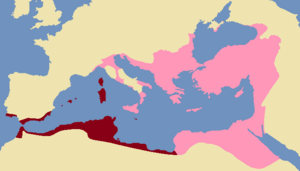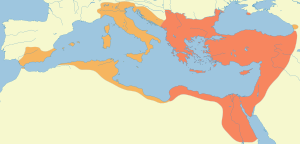Exarchate of Africa facts for kids
Quick facts for kids Exarchate of Africa
Exarchatus Africae
Εξαρχία της Αφρικής |
|||||||||||
|---|---|---|---|---|---|---|---|---|---|---|---|
| Exarchate of the Byzantine Empire | |||||||||||
| 591–698 | |||||||||||
 Map of the Exarchate of Africa within the Byzantine Empire in AD 600. |
|||||||||||
| Capital | Carthage | ||||||||||
| Historical era | Early Middle Ages | ||||||||||
|
• Foundation of Exarchate
|
591 | ||||||||||
|
• First Arab expedition
|
647 | ||||||||||
|
• Battle of Carthage (698)
|
698 | ||||||||||
|
|||||||||||
The Exarchate of Africa was a special part of the Byzantine Empire. It was located around the city of Carthage in North Africa. An "exarch" was like a powerful governor who ruled this area. The Byzantine Emperor Maurice created it in the late 580s. It lasted until the late 600s when Muslim armies conquered the region.
The Exarchate of Africa was one of two such areas. The other was the Exarchate of Ravenna in Italy. These exarchates were set up to better manage lands that the Byzantine Empire had recently won back.
Contents
History of the Exarchate
How it Started
In 533, Byzantine forces led by a general named Belisarius took back North Africa. They also regained Corsica and Sardinia and the Balearic Islands. Emperor Justinian I (who ruled from 527 to 565) organized these lands. He called them the Praetorian prefecture of Africa. Its main city was Carthage.
After Justinian died in 565, the Byzantine Empire faced many attacks. Emperors often left distant areas to manage themselves. However, military leaders like Heraclius the Elder still moved between different provinces. By the 640s, the Byzantines lost land to Muslim armies. This meant they lost experienced officers from those areas.
Creating the Exarchate
The old Roman system kept civil (non-military) and military leaders separate. This was to prevent any one person from becoming too powerful. But Emperor Maurice changed this around 585 to 590. He created the job of "exarch." An exarch had both the top civil power and the top military power. They also had a lot of freedom from the capital city, Constantinople.
Two exarchates were made: one in Italy (called the Exarchate of Ravenna) and one in Africa. The African Exarchate was based in Carthage. It included all Byzantine lands in the western Mediterranean Sea. The first exarch in Africa was a man named Gennadius.
Some changes were made to the provinces. For example, Tripolitania was moved under the control of Egypt. Two areas called Mauretania Caesariensis and Mauretania Sitifensis became "Mauretania Prima." Another area, Mauretania Tingitana, which was mostly just the city of Septum (modern Ceuta), joined with parts of Spain and the Balearic Islands to form "Mauretania Secunda."
The Visigothic Kingdom in Spain was always a threat. The African exarch controlled a small part of southern Spain. This conflict continued until about 624. By then, the Visigoths had taken over the last Byzantine strongholds in Spain. The Byzantines only kept the fort of Septum (Ceuta) across the Strait of Gibraltar.
In 608, the exarch of Carthage, Heraclius the Elder, and his son Heraclius led a successful revolt. Many of the ships that took Heraclius to Constantinople were manned by Berbers. Later, in 647, the Exarch Gregory the Patrician declared himself independent. He was related to the emperor's family. This shows how powerful the exarchate had become. Gregory gathered over 100,000 men, many of them Berber, for the Battle of Sufetula.
The Arab Muslim Conquest
In 647, the first Islamic armies began to move into North Africa. They came from Egypt under the leader Amr ibn al-As. They conquered Barca in Cyrenaica, then moved to Tripolitania.
At this time, there were religious disagreements in the Byzantine Empire. Exarch Gregory the Patrician used this unrest to break away from the empire. Many refugees from Egypt, Palestine, and Syria came to Carthage. This made religious tensions worse and warned Gregory about the approaching Arab threat.
Gregory saw the Muslim forces as the biggest danger. He gathered his allies and fought them. But he was defeated at the Battle of Sufetula. Gregory had moved the capital to Sufetula for better defense against attacks from the sea.
After this defeat, the exarchate became a semi-independent state. A new exarch named Gennadius took over. Trying to pay tribute to both Constantinople and Damascus put a lot of strain on the exarchate. This caused unrest among the people.
The exarchate won a big victory in 682 at the Battle of Vescera. They defeated the forces of Uqba ibn Nafi. The Berber king Kusaila helped them. This victory forced the Muslim armies to retreat to Egypt. This gave the exarchate about ten years of peace. However, the repeated fighting weakened the exarchate's resources.
In 698, the Muslim commander Hasan ibn al-Nu'man attacked Carthage with 40,000 men. Many defenders were Visigoths sent by their king Wittiza, who also feared Muslim expansion. Many Visigoths fought until they died. Carthage was destroyed again, just as it had been centuries earlier by the Romans.
Losing the African Exarchate was a huge blow to the Byzantine Empire. Carthage and Egypt were major sources of soldiers and food for Constantinople. The Byzantines never got their territories in Africa back.
Known Exarchs of Africa
| Time in Office | Name | Notes |
|---|---|---|
| 591–598 | Gennadius (I) | He was the last military commander for Africa and the first Exarch. He won against the Romano-Berber kingdom of Garmul. |
| 598–611 | Heraclius the Elder | He was the father of the later Emperor Heraclius. |
| 611–629 | Niketas | He was a cousin of Emperor Heraclius. He might have been a de facto (unofficial) exarch, acting as governor. |
| 629–647 | Gregory the Patrician | He led a revolt against Emperor Constans II. He was the son of Heraclius's cousin Niketas. |
| 647–665 | Gennadius (II) | He stayed loyal to Emperor Constans II. He was overthrown in a military revolt that led to Constans's death. |
| 665–695 | Eleutherios the Younger | He might have been an Exarch of Africa. He overthrew Gennadios. |
| 695–698 | John the Patrician | He was the Exarch of Africa until the Arabs arrived in 698. |
| 698–709 | Julian, Count of Ceuta | He was the "Commander of Septem" (Ceuta). Some historians believe he was the last Exarch of Africa, but others disagree. |
See also
 In Spanish: Exarcado de África para niños
In Spanish: Exarcado de África para niños


